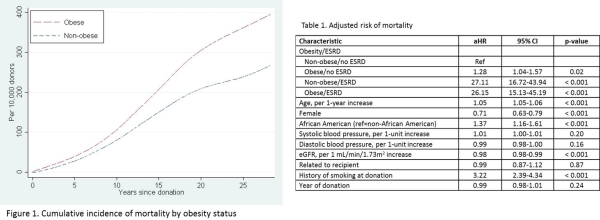Obesity is Associated with Increased Risk of Mortality among Living Kidney Donors
1University of Alabama at Birmingham, Birmingham
2Johns Hopkins University, Baltimore
3University of Pennsylvania, Philadelphia.
Meeting: 2018 American Transplant Congress
Abstract number: B157
Keywords: Multivariate analysis, Outcome, Renal failure, Risk factors
Session Information
Session Name: Poster Session B: Kidney Living Donor: Long Term Outcomes
Session Type: Poster Session
Date: Sunday, June 3, 2018
Session Time: 6:00pm-7:00pm
 Presentation Time: 6:00pm-7:00pm
Presentation Time: 6:00pm-7:00pm
Location: Hall 4EF
Background: Living kidney donor (LKD) demographics have changed, and transplant centers have relaxed selection criteria to include LKDs with obesity. Recently, it has been shown that obese LKDs have increased risk for post-donation end-stage renal disease (ESRD) compared to non-obese LKDs. However, no study to-date has examined post-donation mortality risk among obese LKDs.
Methods: 119,769 LKDs (1987-2013) were studied from the Scientific Registry of Transplant Recipients. Obese LKDs were defined as donors with body mass index (BMI) ≥ 30kg/m2 at donation. Multiple imputation by chained equations was used to impute missing BMI, blood pressure (BP), relationship to recipient, eGFR, and smoking history. Maximum follow-up was 28 years. Outcomes were cumulative incidence (crude estimates and smoothed Kaplan-Meier curves averaged from imputed datasets) and risk of death in Cox proportional hazards regression, with development of ESRD as a time-varying covariate. Risk of ESRD was modeled separately for obese and non-obese LKDs.
Results: Compared to non-obese LKDs, obese LKDs were more likely male (43.1% vs. 39.2%), African American (16.4% vs. 11.1%), and had higher mean systolic BP (124.1 vs. 119.9 mmHg). Unadjusted risk of mortality at 25 years post-donation was 304.3 per 10,000 for obese LKDs and 208.9 per 10,000 for non-obese LKDs (Figure). In the absence of ESRD development, risk of mortality among obese LKDs was 1.3-fold higher than non-obese LKDs (adjusted hazard ratio (aHR): 1.28, 95%CI: 1.04-1.57, p=0.02). For LKDs who developed ESRD, risk of mortality was similar, regardless of obesity status (non-obese/ESRD aHR: 27.11, 95%CI: 16.72-43.94, p< 0.001; obese/ESRD aHR: 26.15, 95%CI: 15.13-45.19, p< 0.001).
Conclusions: Compared with non-obese LKDs, LKDs with obesity at donation had an increased risk of mortality within 28 years of donation. However, presence of obesity at donation does not appear to confer additional mortality risk for donors who develop post-donation ESRD.
CITATION INFORMATION: Reed R., Massie A., Sawinski D., MacLennan P., Shelton B., Mustian M., McWilliams D., Kumar V., Mannon R., Gaston R., Segev D., Lewis C., Locke J. Obesity is Associated with Increased Risk of Mortality among Living Kidney Donors Am J Transplant. 2017;17 (suppl 3).
To cite this abstract in AMA style:
Reed R, Massie A, Sawinski D, MacLennan P, Shelton B, Mustian M, McWilliams D, Kumar V, Mannon R, Gaston R, Segev D, Lewis C, Locke J. Obesity is Associated with Increased Risk of Mortality among Living Kidney Donors [abstract]. https://atcmeetingabstracts.com/abstract/obesity-is-associated-with-increased-risk-of-mortality-among-living-kidney-donors/. Accessed December 31, 2025.« Back to 2018 American Transplant Congress

